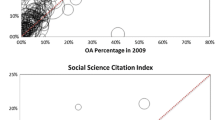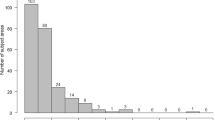Abstract
Aiming to investigate the citation advantage of author-pays model, the present communication compares open access (OA) and Toll Access (TA) papers recognition in author-pays OA journals in 2007–2011. This is the first large scale study concentrating on all APC-funded OA journals published by Springer and Elsevier as the two greatest publishers authorizing and embracing the model. According to the research findings, the OA papers have been exponentially increased in recent years. They are, also, found to outperform the TA ones in their impacts whether in the annual comparisons or across disciplines. The annual OA citation advantages range from 21.36 % for 2009 to 49.71 % for 2008. Social Sciences and Humanities (with 3.14 %) and Natural Sciences (with 35.95 %) gain the lowest and the highest advantages, respectively. The citation advantage can be attributed to the higher visibility of the OA articles, implying the popularity and usefulness of the OA author-pays model to their readership. It may, also, have roots in the selectivity of the authors in choosing the author-pays outlet to publish their high-quality papers, signifying the overall prestige of the OA papers published in the model. Whatever may be the ultimate interpretation, i.e. correlation or causation, the OA citation advantage may encourage the authors who are willing to support OA movement, while seeking to get published in the well-established traditional journals. This may help approach the not-yet-achieved critical mass necessary to evaluate the success of the model.

Similar content being viewed by others
Notes
For a list of OA mandates adopted by universities, research institutions and research funders refer to The Registry of OA Repositories Mandatory Archiving Policies (ROARMAP) at http://roarmap.eprints.org/.
As previously mentioned, not all Gold OA journals are APC-funded.
With the exception of 6 Gold journals including Biointerphases, Biological Procedures Online, Chemistry Central Journal, Geochemical Transactions, Nanoscale Research Letters, Strategies in Trauma and Limb Reconstruction.
The 6 Gold journals mentioned in the previous footnote.
References
Antelman, K. (2004). Do open access articles have a greater research impact?. http://www.ala.org/ala/acrl/acrlpubs/crljournal/crl2004/crlseptember/antelman.pdf.
Atchison, A., & Bull, J. (2015). Will open access get me cited? An analysis of the efficacy of open access publishing in political science. PS. Political Science & Politics, 48(01), 129–137.
Attema, A. E., Brouwer, W., & Van Exel, J. (2014). Your right arm for a publication in AER? Economic Inquiry, 52(1), 495–502.
Beall, J. (2012). Predatory publishers are corrupting open access. Nature News,. doi:10.1038/489179a.
Bernius, S., & Hanauske, M. (2009, January). Open access to scientific literature-increasing citations as an incentive for authors to make their publications freely accessible. In 42nd Hawaii International Conference on System Sciences, 2009. HICSS’09 (pp. 1–9). IEEE.
Bird, C. (2010). Continued adventures in open access: 2009 perspective. Learned Publishing, 23(2), 107–116.
Björk, BC. (2004), Open access to scientific publications: An analysis of the barriers to change Information Research, 9(2), 170. http://InformationR.net/ir/9-2/paper170.html.
Björk, BC. (2012). The hybrid model for open access publication of scholarly articles: A failed experiment? Journal of the American Society for Information Science and Technology. http://www.openaccesspublishing.org/.
Björk, B. C., Laakso, M., Welling, P., & Paetau, P. (2014). Anatomy of green open access. Journal of the Association for Information Science and Technology, 65(2), 237–250.
Björk, B. C., & Solomon, D. (2012). Open access versus subscription journals: A comparison of scientific impact. BMC Medicine, 10, 73–90.
Björk, BC., & Solomon, D. (2014a). Developing an effective market for open access article processing charges. http://www.wellcome.ac.uk/stellent/groups/corporatesite/@policy_communications/documents/web_document/wtp055910.pdf.
Björk, B. C., & Solomon, D. (2014b). How research funders can finance APCs in full OA and hybrid journals. Learned Publishing,. doi:10.1087/20140203.
Brody, T., Stamerjohanns, H., Harnad, S., Gingras, Y., Vallieres, F., & Oppenheim C. (2004). The effect of open access on citation impact. Presented at: National Policies on Open Access (OA) Provision for University Research Output: An International meeting. Southampton University, Southampton UK. 19 February 2004. http://opcit.eprints.org/feb19prog.html.
Chaudhuri, J., & Thohira, M. (2010). Usage of open access journals: Findings from eleven top science and medical journals. The Serials Librarian, 58, 97–105.
Craig, I. D., Plume, A. M., McVeigh, M. E., Pringle, J., & Amin, M. (2007). Do open access articles have greater citation impact?: a critical review of the literature. Journal of Informetrics, 1(3), 239–248.
Davis, P. M., & Fromerth, M. J. (2007). Does the arXiv lead to higher citations and reduced publisher downloads for mathematics articles? Scientometrics, 71(2), 203–215.
Eysenbach, G. (2006a). Citation advantage of open access articles. PLoS Biology, 4(5), e157. doi:10.1371/journal.pbio.0040157.
Eysenbach, G. (2006b), The open access advantage. Journal of Medical Internet Research, 8(2): e8. http://www.jmir.org/2006/2/e8/.
Finch, J. (2012). Accessibility, sustainability, excellence: How to expand access to research publications. http://www.researchinfonet.org/publish/finch/.
Gargouri, Y., Hajjem, C., Larivière, V., Gingras, Y., Carr, L., et al. (2010). Self-selected or mandated, open access increases citation impact for higher quality research. PLoS ONE, 5(10), e13636.
Gaule, P., & Mayster, N. (2011). Getting cited: Dose open access help? Research Policy, 40, 1332–1338.
Goodman, D. (2004). The criteria for OA. Serials Review, 30, 258–270.
Guédon, J. C. (2004). The green and gold roads to OA: The case for mixing and matching. Serials Review, 30, 315–328.
Hajjem, C., Gingras, Y., Brody T., Carr, L., & Harnad, S. (2005a), Open access to research increases citation impact. http://eprints.ecs.soton.ac.uk/11687/01/chawki2.doc/.
Hajjem, C., Harnad, S., Gingras, Y. (2005b), Ten-year cross-disciplinary comparison of the growth of open access and how it increases research citation impact. IEEE Data Engineering Bulletin 28(4), 39–46. http://sites.computer.org/debull/A05dec/hajjem.pdf.
Harnad, S. (2005), Fast-forward on the green road to open access: The case against mixing up green and gold, Ariadne, no. 42 (2005). http://www.ariadne.ac.uk/issue42/harnad/.
Harnad, S. (2006), Publish or perish—self-archive to flourish: The green route to OA. ERCIM News, 64. http://eprints.ecs.soton.ac.uk/11715/.
Harnad, S. (2012). Hybrid gold open access and the Chesire cat’s grin: How to repair the new open access policy of RCUK. LSE Impact of Social Sciences. http://eprints.soton.ac.uk/342582/.
Harnad, S. (2014) Open access: What, where, when, how and why. In: J. Britt Holbrook & C. Mitcham (Eds.), Ethics, science, technology, and engineering: An international resource, (2nd of Encyclopedia of Science, Technology, and Ethics, Gale-Cengage, MacMillan Reference).
Harnad, S. & Brody, T. (2004). Comparing the impact of open access (OA) vs. TA articles in the same journals. D-Lib Magazine, 10(6). http://www.dlib.org/dlib/june04/harnad/06harnad.html.
Harnad, S., Brody, T., Vallieres, F., Carr, L., Hitchcock, S., Gingras, Y., et al. (2004). The access/impact problem & the green & gold roads to open access. Serials Review,. doi:10.1016/j.serrev.2004.09.013.
Harnad, S., Brody, T., Vallières, F., Carr, L., Hitchcock, S., Gingras, Y., et al. (2008). The access/impact problem and the green and gold roads to open access: An update. Serials Review, 34(1), 36–40. doi:10.1016/j.serrev.2007.12.005.
Jackson, J. B., & Anderson, R. (2014). Anthropology and open access. Cultural Anthropology, 29(2), 236–263.
Kiley, R. (2014). Mandating open access: The view from the wellcome trust. http://www.slideshare.net/wellcome/mandating-open-access-wellcome-trust-presentation.
Koler-Povh, T., Južnič, P., & Turk, G. (2014). Impact of open access on citation of scholarly publications in the field of civil engineering. Scientometrics, 98(2), 1033–1045.
Kurtz, M. J., Eichhorn, G., Accomazzi, A., Grant, C. S., Demleitner, M., Murray, S. S., et al. (2004a). The bibliometric properties of article readership information. Journal of the American Society for Information Science and Technology, 56(2), 111–128.
Kurtz, M. J., Eichhorn, G., Accomazzi, A., Grant, C., Demleitner, M., et al. (2005). The effect of use and access on citations. Information Processing and Management, 41(6), 1395–1402.
Kurtz, M. J., Eichhorn, G., Accomazzi, A., Stern-Grant, C., Demleitner, M., & Murray, S. S. (2004b), Worldwide use and impact of the NASA Astrophysics Data System digital library. Journal of the American Society for Information Science 56(1), 36–45. http://cfa-www.harvard.edu/~kurtz/jasist1.pdf. Kurtz.
Kurtz, M. J., & Henneken, E. A. (2007). Open access does not increase citations for research articles from The Astrophysical Journal. arXiv preprint arXiv: 0709.0896. http://arxiv.org/pdf/0709.0896.
Laakso, M. (2014). Green open access policies of scholarly journal publishers: a study of what, when, and where self-archiving is allowed. Scientometrics, 99(2), 475–494.
McCABE, M., & Snyder, C. M. (2014). Identifying the effect of Open Access on citations using a panel of science journals. Economic Inquiry, 52(4), 1284–1300.
McVeigh, M. (2004). Open access journals in the ISI citation databases: Analysis of impact factors and citation patterns. http://science.thomsonreuters.com/m/pdfs/openaccesscitations2.pdf.
Migheli, M., & Ramello, G. B. (2014). Open access journals and academics’ behavior. Economic Inquiry, 52(4), 1250–1266.
Miguel, S., Chinchilla-Rodriguez, Z., & de Moya-Anegón, F. (2011). Open access and Scopus: A new approach to scientific visibility from the standpoint of access. Journal of the American Society for Information Science and Technology, 62(6), 1130–1145.
Moed, H. F. (2006). Citation analysis in research evaluation (Vol. 9). Dordrecht: Springer.
Moed, H. F. (2007). The effect of ‘open access’ on citation impact: An analysis of ArXiv’s condensed matter section. Journal of the American Society for Information Science and Technology, 58(13), 2047–2054.
Mueller-Langer, F., & Watt, R. (2014). The hybrid open access citation advantage: How many more cites is a $3,000 fee buying you?. Max Planck Institute for Innovation & Competition Research Paper, (14-02). http://ssrn.com/abstract=2391692.
Nicholas, D., Huntington, P., & Rowlands, I. (2005). Open access journal publishing: The views of some of the world’s senior authors. Journal of Documentation, 61(4), 497–519.
Park, J. H., & Qin, J. (2007). Exploring the willingness of scholars to accept open access: A grounded theory approach. Journal of Scholarly Publishing, 38(2), 55–84.
Pinfield, S., Salter, J., & Bath, P. A. (2015). The ‘total cost of publication’ in a hybrid open-access environment: Institutional approaches to funding journal article-processing charges in combination with subscriptions. Journal of the Association for Information Science and Technology. (In Press).
Prosser, D. (2003). Institutional repositories & open access: The future of scholarly communication. Information Services & Use, 23, 167–170.
RCUK. (2012). RCUK announces block grants for universities to aid drives to open access to research outputs. http://www.rcuk.ac.uk/media/news/2012news/Pages/121108.aspx.
Riera, M., & Aibar, E. (2013). Does open access publishing increase the impact of scientific articles? An empirical study in the field of intensive care medicine. Medicina Intensiva, 37(4), 232–240.
Solomon, D. J., Laakso, M., & Björk, B. C. (2013). A longitudinal comparison of citation rates and growth among open access journals. Journal of Informetrics, 7(3), 642–650.
Stange, K. (2005). Library consortia and open access initiatives. Info Trend, 60(4), 107–112.
Stern, N. (2014, September). The making of a mandate: A regional approach to open access. In Septentrio Conference Series (No. 1). doi:10.7557/5.3146.
Suber, P. (2006). Nine questions for hybrid journal programs. SPARC Open Access Newsletter, 101, September 2. http://www.earlham.edu/~peters/fos/newsletter/09-02-06.htm.
Swan, A. (2010). The Open Access citation advantage: studies and results to date. Technical Report, School of Electronics & Computer Science, University of Southampton. http://openaccess.eprints.org/index.php?/archives/716-Alma-Swan-Review-of-Studies-on-Open-Access-Impact-Advantage.html.
Swan, A., & Brown, S. (2004a). Authors and open access publishing. Learned Publishing, 17(3), 219–224.
Swan, A. & Brown, S. (2004b). JISC/OSI journal authors survey report. Truro, Key Perspectives Ltd. http://wwww.jisc.ac.uk/uploaded_documents/JISCOAreport1.pdf.
The Economist. (2012). Brought to book: Academic journals face a radical shake-up. July 21 2012. http://www.economist.com/node/21559317. Accessed 31July 2012.
Velterop, J. (2007). Open access is a choice. Humboldt University. http://edoc.huberlin.de/oa/articles/reml4evBkibI/PDF/26OGwKncskJbU.pdf.
Wagner, A. (2010). Open access citation advantage: an annotated bibliography. http://www.istl.org/10-winter/article2.html.
Warlick, SE. & Vaughan, K.T.L. (2007). Factors influencing publication choice: Why faculty choose open access. Biomedical Digital Library 4(1). http://www.pubmedcentral.nih.gov/picrender.fcgi?artid=1832213&blobtype=pdf&tool=pmcentrez.
Watson, C. A., Donovan, J. M., & Osborne, C. (2015). The open access advantage for American law reviews. http://digitalcommons.law.uga.edu/fac_artchop/989/.
Weber, D. (2009). Hybrid OA journals: A progression or a destination. http://eprints.rclis.org/13744/1/Hybrid_OA_Journals.pdf.
Xia, J., Myers, R. L., & Wilhoit, S. K. (2011). Multiple open access availability and citation impact. Journal of Information Science, 37(1), 19–28.
Xia, J., & Nakanishi, K. (2012). Self-selection and the citation advantage of open access articles. Online Information Review, 36(1), 40–51.
Author information
Authors and Affiliations
Corresponding author
Appendix
Rights and permissions
About this article
Cite this article
Sotudeh, H., Ghasempour, Z. & Yaghtin, M. The citation advantage of author-pays model: the case of Springer and Elsevier OA journals. Scientometrics 104, 581–608 (2015). https://doi.org/10.1007/s11192-015-1607-5
Received:
Published:
Issue Date:
DOI: https://doi.org/10.1007/s11192-015-1607-5




